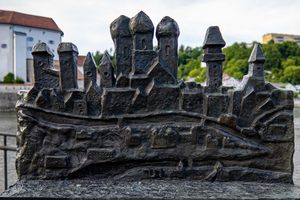The Ortsspitze is a small park at the eastern end of Passau in Lower Bavaria. At its tip lies the Dreiflüsseeck, where Passau’s three rivers–Inn, Ilz, and Danube–conjoin. For the next twenty kilometers, the Danube straddles the German-Austrian border before it becomes a completely Austrian river at Engelhartszell.
The rivers’ personalities are apparent from both the ground and from the lookout points on surrounding hills. The inky Ilz, “the black pearl of the Bavarian Forest,” slinks slowly through the peat and spruce forests of the Bavarian Forest. The blue (or sometimes brown) Danube, which begins six hundred kilometers west in Donaueschingen in the Black Forest, ambles without haste. The grayish-green Inn, which rises in the Swiss Alps, rushes with urgency through Austria and Bavaria before plowing into the Danube from the south. From above, particularly in summer when snowmelt is highest, the Inn appears to swallow both rivers whole. After the Dreiflüsseeck, the Danube’s color more resembles the Inn than it had before Passau.
The Dreiflüsseck is also an excellent tourist attraction in its own right. Kids can play on the playground or follow the 1:1 billion-scale “Planetenweg” — a 1:1 billion scale model of the solar system which begins at the Ortsspitze and stretches 4.8 kilometers along the Inn. History buffs can also look to the south across the Inn toward see Mariahilf Abbey (where Mozart once worshipped or where Austrian Kaiser Leopold absconded to pray for victory over the Turks in 1683) or the north to Veste Oberhaus, once the stronghold of Passau’s ruling prince bishops. At the tip of the Ortsspitze’s tongue lies an anchor, a monument to the victims of the Danube, which was placed in 1971. At the back of the park stand remnants of Passau’s medieval city wall, which began construction in 1250. The visible portion is from the sixteenth century.
